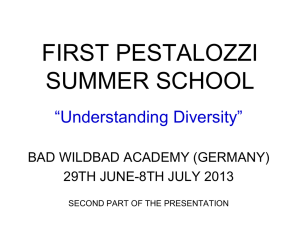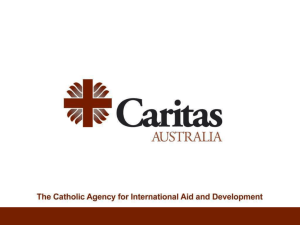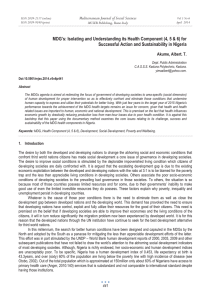07 1 MDGs
advertisement
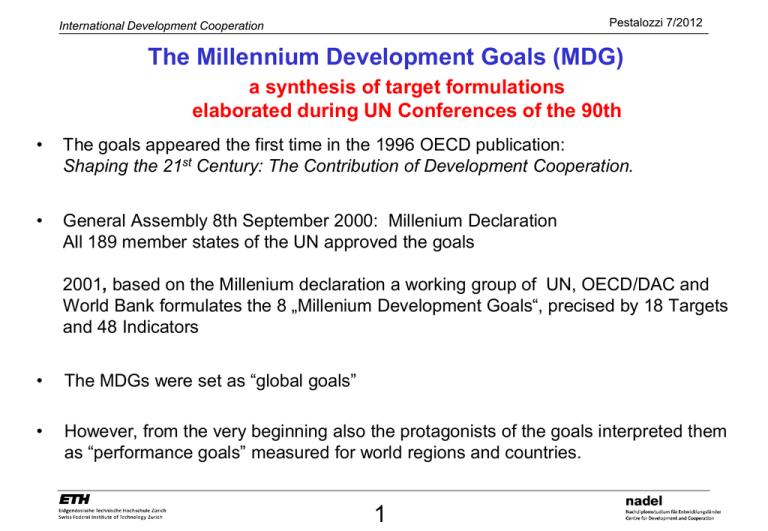
Pestalozzi 7/2012 International Development Cooperation The Millennium Development Goals (MDG) a synthesis of target formulations elaborated during UN Conferences of the 90th • The goals appeared the first time in the 1996 OECD publication: Shaping the 21st Century: The Contribution of Development Cooperation. • General Assembly 8th September 2000: Millenium Declaration All 189 member states of the UN approved the goals 2001, based on the Millenium declaration a working group of UN, OECD/DAC and World Bank formulates the 8 „Millenium Development Goals“, precised by 18 Targets and 48 Indicators • The MDGs were set as “global goals” • However, from the very beginning also the protagonists of the goals interpreted them as “performance goals” measured for world regions and countries. 1 Pestalozzi 7/2012 International Development Cooperation The 8 MDGs selected indicators 2.1 Net enrolment ratio in primary education 2.2 Proportion of pupils starting grade 1 who reach last grade of primary 2.3 Literacy rate of 15-24 year-olds, women and men ensure that, by 2015, children everywhere, boys and girls alike, will be able to complete a full course of primary schooling eliminate gender disparity in primary and secondary education preferably by 2005, and at all levels by 2015 3.1 Ratios of girls to boys in primary, secondary and tertiary education 6.1 HIV prevalence among population aged 15-24 years 6.3 Proportion of population aged 15-24 years with comprehensive correct knowledge of HIV/AIDS 6.4 Ratio of school attendance of orphans to school attendance of non-orphans aged 10-14 years 6.7 Proportion of children under 5 sleeping under insecticide-treated bednets 6.8 Proportion of children under 5 with fever who are treated with appropriate anti-malarial drugs 2 Pestalozzi 7/2012 International Development Cooperation Summary of the current achievements on the way to reach the MDGs reached success based on 2009 data necessary success to reach 2015 target 3 Pestalozzi 7/2012 International Development Cooperation MDG Indicator progress, number of poor countries Sample size: 76 countries, IDA-eligible 4 Pestalozzi 7/2012 International Development Cooperation Top MDG Index Performers Lowest MDG Index Performers 5 Pestalozzi 7/2012 International Development Cooperation Millennium Development Goals ad Midpoint: Where do we stand and where do we need to go? • Global progress is surprisingly good, especially for the poverty and the gender parity goals; less so for the child mortality and maternal mortality goal. • In effect, there are clear regional patterns in MDG progress that depend on initial conditions and recent growth performance. Asian countries are over-achievers in the income poverty goal. Latin America and Middle East relative overachievers in health, education and gender equity. Relative underachievers in poverty reduction goal, although their poverty level is low by international standards perform relatively worse in health and, in the case of South Asia, in education and gender equity. • Progress on poverty is very much driven by overachievers in East and South Asia. Sub-Saharan African countries lag significantly behind other regions in all MDGs. 6 (Bourgignon et al. ,2008) Pestalozzi 7/2012 International Development Cooperation Summary • The MDGs’ achievement gap is much larger in ‘fragile’ states. one of the reasons why Sub-Saharan Africa lags behind on MDG progress is the relatively large proportion of so-called ‘fragile states’ in that region • The poorest regions, South Asia and Sub-Saharan Africa, are the two regions still seriously off- track for pimary completion rates and for child mortality. • Progress has been good on gender equity in primary and secondary enrolments in all regions. Yet Sub-Saharan Africa and fragile states still lag considerably behind. Not a single country in Sub- Saharan Africa is on track to meet the goal at this stage. 7 Pestalozzi 7/2012 International Development Cooperation MLM • MDG 2 • Recht auf Bildung 11
